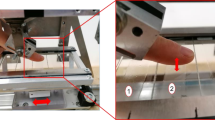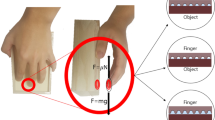Abstract
The fingernails are generally used for a variety of functions including protecting, foraging, and gripping. The achievement of these functions depends on the mechanical properties of fingernails. In this article, the deformation recovery of human fingernails in water was investigated. The effect of water on the mechanical and frictional behaviors of fingernails was studied using a nano indentation and scratch tester. Owing to the swelling of fingernail matrix, the indents under a peak indentation load of 20 N and scratches under a constant load of 70 mN can be fully recovered after the fingernail samples were dipped in water for 10 min. The recovery of these deformations in water reveals obvious anisotropy on the different sections of fingernails. The recovery speed of the indents and scratches on the surface of fingernails is the fastest, and the slowest recovery happens for the deformations on the longitudinal section. With the water in hydrated fingernails evaporating in air, the microhardness of fingernails shows a quick increase in the first 100 min and levels off after 200 min. Finally, the microhardness of fingernails in the fully dehydrated state is 2–3 times larger than that in the hydrated state. The water in fingernails reduces the fluctuation of friction force on surface and protects the surface of fingernails from scratch damage. Owing to the special orientation of filament in the intermediate layer of fingernails, the friction on the cross section of fingernail shows an anisotropic behavior. Either on the dehydrated or hydrated fingernails, the friction coefficient along the parallel direction of filament is lower than that along the vertical direction of filament.














Similar content being viewed by others
References
Ross, M.H., Kaye, G.I., Pawlina, W.: Histology: A Text and Atlas. Lippincott Williams & Wilkins (2002)
Hamrick, M.W.: Functional and adaptive significance of primate pads and claws: evidence from New World anthropoids. Am. J. Phys. Anthropol. 106, 113–127 (1998)
Seki, Y., Schneider, M.S., Meyers, M.A.: Structure and mechanical behavior of a toucan beak. Acta Mater. 53, 5281–5296 (2005)
Bonser, R.H.C.: Hydration sensitivity of ostrich claw keratin. J. Mater. Sci. Lett. 21, 1563–1564 (2002)
Kitchener, A., Vincent, J.F.V.: Composite theory and the effect of water on the stiffness of horn keratin. J. Mater. Sci. 22, 1385–1389 (1987)
Taylor, A.M., Bonser, R.H.C., Farrent, J.W.: The influence of hydration on the tensile and compressive properties of avian keratinous tissues. J. Mater. Sci. 39, 939–942 (2004)
Kitchener, A.: Effect of water on the linear viscoelasticity of horn sheath keratin. J. Mater. Sci. Lett. 6, 321–322 (1987)
Bertram, J.E.A., Gosline, J.M.: Functional design of horse hoof keratin: the modulation of mechanical properties through hydration effects. J. Exp. Biol. 130, 121–136 (1987)
Soligo, C., Muller, A.E.: Nails and claws in primate evolution. J. Hum. Evol. 36, 97–114 (1999)
Achten, G.: Histopathology of the nail. In: Pierre, M. (ed.) The Nail, pp. 1–14. Churchill Livingstone, Edinburgh (1981)
Baden, H.P.: The physical properties of nail. J. Invest. Dermatol. 55, 115–122 (1970)
Caputo, R., Gasparini, G., Contini, D.: A freeze-fracture study of the human nail plate. Arch. Dermatol. Res. 272, 117–125 (1982)
Farren, L., Shayler, S., Ennos, A.R.: The fracture properties and mechanical design of human fingernails. J. Exp. Biol. 207, 735–741 (2004)
Garson, J.C., Baltenneck, F., Leroy, F., Riekel, C., Müller, M.: Histological structure of human nail as studied by synchrotron X-ray microdiffraction. Cell. Mol. Biol. 46(6), 1025–1034 (2000)
Farran, L., Ennos, A.R., Eichhorn, S.J.: Microindentation and nanoindentation of human fingernails at varying relative humidity. J. Mater. Res. 24, 980–984 (2009)
Leffell, D.J.: Total Skin: The Definitive Guide to Whole Skin Care for Life. Hyperion, New York (2000)
Egawa, M., Ozaki, Y., Takahashi, M.: In vivo measurement of water content of the fingernail and its seasonal change. Skin Res. Technol. 12, 126–132 (2005)
Gniadecka, M., Nielsen, O.F., Christensen, D.H., Wulf, H.C.: Structure of water, proteins, and lipids in intact human skin, hair, and nail. J. Invest. Dermatol. 110, 393–398 (1998)
Fraser, R.D.B., Macrae, T.P.: Molecular structure and mechanical properties of keratins. Symp. Soc. Exp. Biol. 34, 211–246 (1980)
Finlay, A.Y., Prost, P., Keith, A.D., Snipes, W.: An assessment of factors influencing flexibility of human fingernails. Br. J. Dermatol. 103, 357–365 (1980)
Farran, L., Ennos, A.R., Eichhorn, S.J.: The effect of humidity on the fracture properties of human fingernails. J. Exp. Biol. 211, 3677–3681 (2008)
Zheng, J., Zhou, Z.R.: Effect of age on the friction and wear behaviors of human teeth. Tribol. Int. 39(3), 266–273 (2006)
Paolo, U.G., Thomas, M., Matthew, T.: Gender-linked differences in human skin. J. Dermatol. Sci. 55(3), 144–149 (2009)
Guo, B., Liao, D., Li, X., Zeng, Y., Yang, Q.: Age and gender related changes in biomechanical properties of healthy human costal cartilage. Clin. Biomech. 22(3), 292–297 (2007)
Bonser, R.H.C.: Melanin and the abrasion resistance of feathers. Condor 97, 590–591 (1995)
Zheng, J., Zhou, Z.R., Zhang, J., Li, H., Yu, H.Y.: On the friction and wear behaviour of human tooth enamel and dentin. Wear 255, 967–974 (2003)
Schulz, B., Chan, D., Bäckström, J., Rübhausen, M., Wittern, K.P., Wessel, S., Wepf, R., Williams, S.: Hydration dynamics of human fingernails: an ellipsometric study. Phys. Rev. E 65(6), 061913.1–061913.7 (2002)
Moran, P., Towler, M.R., Chowdhury, S., Saunders, J., German, M.J., Lawson, N.S., Pollock, H.M., Pillay, I., Lyons, D.: Preliminary work on the development of a novel detection method for osteoporosis. J. Mater. Sci. Mater. Med. 18, 969–976 (2007)
Qian, L.M., Li, M., Zhou, Z.R., Yang, H., Shi, X.Y.: Comparison of nano-indentation hardness and micro hardness. Surf. Coat. Technol. 195(2–3), 264–271 (2005)
Mclachlan, A.D.: Coiled-coil formation and sequence regulations in the helical regions of α-keratin. J. Mol. Biol. 124, 297–304 (1978)
Berg, J.M., Tymoczko, J.L., Stryer, L.: Biochemistry, 5th edn. W. H. Freeman, New York (2002)
Danilatos, G., Feughelman, M.: The microfibril-matrix relationships in the mechanical properties of keratin fibers. Part II. The mechanical properties of the matrix during the extension of an α-keratin fiber. Text. Res. J. 50, 568–574 (1980)
Feughelman, M.: A two-phase structure for keratin fibers. Text. Res. J. 29, 223–228 (1959)
Liu, X.X., Li, T.S., Liu, X.J., Lv, R.G., Cong, P.H.: An investigation on the friction of oriented polytetrafluoroethylene (PTFE). Wear 262, 1414–1418 (2007)
Acknowledgments
The authors acknowledge with thanks the financial support from the Natural Science Foundation of China (90923017, 50625515, 50821063, and 50805124). In addition, the authors would like to thank Prof. Shuxin Qu for the discussion on the manuscript.
Author information
Authors and Affiliations
Corresponding author
Rights and permissions
About this article
Cite this article
Wei, P., Qian, L., Zheng, J. et al. Effect of Water on the Mechanical and Frictional Behaviors of Human Fingernails. Tribol Lett 38, 367–375 (2010). https://doi.org/10.1007/s11249-010-9616-2
Received:
Accepted:
Published:
Issue Date:
DOI: https://doi.org/10.1007/s11249-010-9616-2




